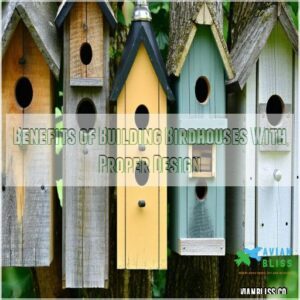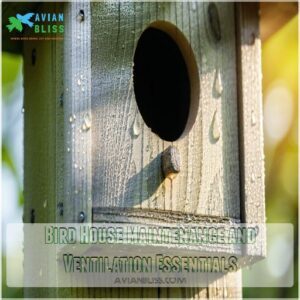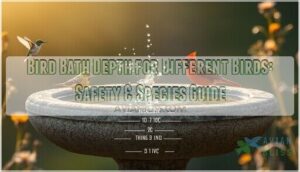This site is supported by our readers. We may earn a commission, at no cost to you, if you purchase through links.
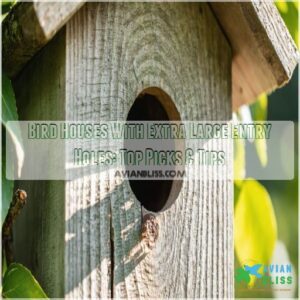 Choosing bird houses with extra large entry holes is like rolling out the red carpet for bigger birds like screech owls and flickers.
Choosing bird houses with extra large entry holes is like rolling out the red carpet for bigger birds like screech owls and flickers.
A spacious entrance, around 2.5 inches, lets these feathered friends settle easily but also attracts some unexpected visitors.
To keep predators at bay, consider adding a metal plate or sturdy wire around the entry.
Houses like the Cedar Screech Owl Nest Box provide excellent accommodations and are handcrafted with a large swing-up door for easy access.
Remember, the right location and protection transform your backyard into a safe haven. Stick around for more handy tips!
Table Of Contents
- Key Takeaways
- Bird House Entrance Hole Size Matters
- Top 4 Birdhouses With Extra Large Entry Holes
- Placement Considerations for Bird Houses
- Benefits of Building Birdhouses With Proper Design
- Bird House Maintenance and Ventilation Essentials
- Frequently Asked Questions (FAQs)
- What size entrance hole for bird house?
- Where not to put a bird house?
- Can a birdhouse hole be too big?
- What is the best birdhouse to attract birds?
- How do large entry holes affect safety?
- What species prefer larger entry holes?
- Are certain materials better for large holes?
- How do predators exploit large entry holes?
- Can large entry holes lead to overpopulation?
- Conclusion
Key Takeaways
- Choose birdhouses with large entry holes, around 2.5 inches, to welcome bigger birds like screech owls and flickers, but be cautious of attracting predators.
- Install metal plates or sturdy wires around the entrance to keep predators out and ensure your birdhouses are safe.
- Position birdhouses at a height that deters predators but allows easy cleaning, and avoid high-traffic areas for a stress-free environment.
- Regularly clean and maintain proper ventilation in your birdhouses to create a healthy nesting space for your feathered friends.
Bird House Entrance Hole Size Matters
When it comes to birdhouses, the size of the entrance hole isn’t just a minor detail; it’s a crucial factor that decides which feathered friends can move in.
Larger holes might seem inviting but can lead to unwanted guests and predators making themselves at home, so picking the right size keeps your birdhouse both welcoming and safe.
Entrance Hole Size by Species
Getting the entrance hole size just right is key for attracting the right bird species. Think of it like fitting Cinderella’s slipper! Different birds, different needs.
For example, if you’re looking to attract Eastern Bluebirds, you’ll want to make sure your birdhouse has specific features, such as a 1.5-inch diameter entrance hole, as recommended for a bluebird house design](https://avianbliss.com/bird-house-for-bluebirds/).
Here’s a quick peek at some sizes:
- Chickadees need about 1 1/8-inch diameter.
- Bluebirds prefer 1 1/2 inches.
- Flickers go for a big 2 1/2 inches.
Risks of Larger Entrance Holes That Are Too Large
Oversized birdhouse openings can invite trouble with increased predation and competing species.
Imagine throwing a party and everyone’s crashing your space, even those you didn’t invite. Birds might get injured, and nest failure becomes more likely.
Weather vulnerability also spikes when houses are ill-suited for smaller residents, making it a gamble without a proper bird house hole size chart to guide you.
Entrance Hole Size and Predator Protection
A birdhouse with an oversized opening can invite unwanted guests. Cleverly managing entry hole size helps keep predators out.
- Predator guards: Metal plates or sturdy wires can shield vulnerable entry points.
- Hole size variations: Smaller holes suitable for the type of bird you want to protect.
- Placement impact: High and away from reach reduces risks.
Tweak these factors for safer bird homes!
Top 4 Birdhouses With Extra Large Entry Holes
You’ll find four excellent birdhouses perfect for larger birds.
Each is chosen for its quality and spacious entrance hole.
We’ve carefully selected these options to help you attract a wider variety of feathered friends to your backyard.
1. Cedar Bluebird House Bird Viewing

A bluebird house like this is a cozy haven for feathered friends. Crafted from premium cedar with stainless steel hardware, the Cedar Bluebird House from Nature’s Way promises durability and charm. Its natural cedar color with a protective stain blends perfectly into any backyard setting.
This birdhouse features a large hole entrance which is similar to bluebird house large hole designs available online at bluebird house products.
The stay-clear viewing window offers an intimate glimpse into bird life, while the predator guard and elevated mesh floor guarantee safety.
Easy to clean with versatile mounting options, it’s a true gem for any bird enthusiast seeking to attract bluebirds.
Best For: Bird enthusiasts looking to attract and support bluebird families in their backyard.
- Durable cedar construction with stainless steel hardware for longevity.
- Stay-clear viewing window for birdwatching enjoyment.
- Versatile mounting options for various settings.
- Some reports of damaged boxes upon arrival and missing viewing windows.
- Mesh floor may require modification for optimal nesting success.
- Entrance hole size might need adjustment to deter larger birds.
2. Cedar Wren House Birdhouse Nature Way

Consider adding the Cedar Wren House Birdhouse from Nature Way to your garden.
It’s designed with wren and chickadee nesting in mind, featuring a 1 1/8" entrance that keeps pesky sparrows out.
Crafted from premium cedar, it’s durable and offers maximum air ventilation through cleverly placed vents, ensuring your feathered friends are comfy and safe.
Plus, it comes with a sturdy hanging hook and an easy clean-out door.
Bird lovers appreciate how well it attracts these small birds, making it a superb choice.
Best For: Bird lovers looking to attract wrens and chickadees to their garden.
- Made with durable cedar wood and rust-free hardware.
- Features air vents for optimal bird health and a 1 1/8" entrance hole to deter larger birds.
- Includes a convenient clean-out door and sturdy hanging hook.
- May need to be cleaned before each nesting season.
- May require protection from squirrels and other predators.
- Might be too late in the year for birds to use it effectively.
3. Cedar Screech Owl Nest Box USA Made

You won’t believe how the Cedar Screech Owl Nest Box, made in the USA, does more than just look pretty.
Handcrafted from robust cedar, it offers durability and insulation to keep owls cozy.
Its swing-up front door makes cleaning a breeze, like lifting the hood of an old Chevy.
While the top mounting holes might be a hassle, the sturdy design compensates well. For best results, mount it high in a dense tree and consider pre-drilling holes for easier installation. Sturdy design and easy cleaning.
Best For: Those wanting a high-quality, durable, and attractive owl house made in the USA.
- Sturdy cedar wood construction for owl protection and longevity.
- Easy-to-clean swing-up front door.
- Successfully attracts and shelters screech owls.
- Potential for squirrel infestation.
- Mounting holes may be difficult to access.
- Some reported issues with screw alignment.
4. Whitehorse Premium Cedar Bluebird House
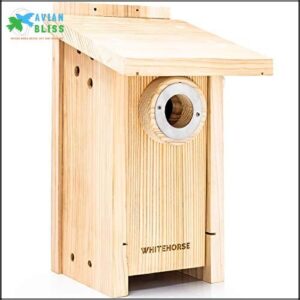
The Whitehorse Premium Cedar Bluebird House is a top pick for bird lovers looking to invite Eastern Bluebirds and more to their yards.
Crafted from 3/4" thick Western Cedar, it’s sturdy and weatherproof with features like angled vent holes and a recessed floor.
The 1.5" entry hole fits bluebirds perfectly while keeping pesky predators out, adhering to the important entrance hole size guidelines (https://avianbliss.com/best-bird-houses-for-bluebirds/).
With its easy-to-clean hinged front and wire mesh floor, maintaining this birdhouse is a breeze.
Plus, it comes with installation tips and a bird attraction guide, ensuring you’re set for aviary success.
Best For: Bird enthusiasts seeking a high-quality, durable bluebird house that’s easy to clean and maintain.
- Superior craftsmanship and weatherproof design using durable Western Cedar.
- Easy-to-clean hinged front and wire mesh floor for simple maintenance.
- Includes installation tips and a bird attraction guide for successful placement.
- May require additional screws for mounting on metal poles.
- Could benefit from a bundled support pole option for easier installation.
- While attractive, the natural cedar color might not suit all aesthetics.
Placement Considerations for Bird Houses
When placing birdhouses with extra large entry holes, you’ll want to make certain they’re mounted at the right height and away from predators for the best protection.
Also, think about keeping them away from feeders and busy areas to give birds a peaceful home.
plus consider using predator guards and baffles for extra safety.
Mounting Height and Predator Protection
Choosing a spot for your extra large birdhouse means thinking like a bird.
Make it predator-proof by mounting it high enough to deter chance encounters but within reach for cleaning.
Mounting Ideas:
- Use a baffle to discourage climbers.
- Install predator guards for safety.
- Stick to safe heights—at least 6 feet off the ground.
Location Selection Based on Species
Smart birdhouse placement is key! Different birds have different preferences.
| Species | Ideal Location | Notes |
|---|---|---|
| Bluebirds | Open areas, near trees | Needs sunny spots, minimal overhead cover |
| Chickadees | Dense shrubs, wooded edges | Prefers protection from wind and rain |
| Wrens | Sheltered spots, close to ground | Needs lots of hiding spots, thick cover |
Consider these factors for successful nesting:
Remember, understanding species preferences is half the battle in attracting feathered friends.
Avoiding Feeders and High-Traffic Areas
When setting up your birdhouse, think of it like picking the perfect house in a quiet neighborhood.
Avoid placing it near bird feeders or busy areas—birds appreciate privacy, just like we do.
It reduces human impact and keeps predators at bay. Choosing a quiet zone guarantees your feathered friends feel safe and comfy in their extra-large entry birdhouse.
Using Predator Guards and Baffles
It’s a jungle out there, so protect your feathered friends with predator guards and baffles.
- Install guards and baffles to deter pesky predators like raccoons and cats.
- Choose different types of guards for your wide entry birdhouse.
- DIY baffle ideas can be both effective and fun.
Keep your birdhouses safe and sound!
Benefits of Building Birdhouses With Proper Design
When you build birdhouses with a proper design, you’re giving birds a safe place to nest.
Supporting local ecosystems is another benefit. A well-crafted birdhouse can help control pests, improve soil quality, and even make your garden a more lively and enjoyable spot for bird watching.
Providing Safer Nesting Sites for Birds
Birdhouses are more than just backyard decor, they’re safe havens for cavity nesting birds like owls.
With proper nest box design, using quality nest box materials and ensuring thoughtful site selection, you create safe spaces away from predators.
Plus, maintaining a regular maintenance schedule keeps things comfy for your feathered guests.
| Birdhouse Type | Purpose | Key Feature |
|---|---|---|
| Owl Box | Nesting | Wide Entry |
| Bluebird House | Predator Safe | Extra Large Entry |
| Wren House | Shelter | Durable Materials |
Supporting Local Bird Populations and Ecosystems
Creating birdhouses boosts local bird populations, helping sustain ecosystems amidst habitat loss. By offering safe spaces, you support cavity nesting birds like chickadees and wrens. Consider using birdhouses with large openings, available at large birdhouse stores, to attract a wider variety of species.
- Diverse diets aid in pest control.
- Nest materials utilize natural resources.
- Citizen science observations.
- Predator control through design.
- Compatibility with a birdhouse hole size chart.
Contribute to nature while enjoying their company!
Promoting Pest Control and Soil Quality
While birdhouses support wildlife, they also help with natural pest control by attracting species that munch on pesky insects.
Imagine welcoming beneficial birds into your garden! They gobble up bugs like a free pest patrol, improving soil health.
Thoughtful birdhouse designs with birdproofing and wildlife exclusion guarantee your garden crew—European Starlings and House Sparrows—fits right in, enhancing ecosystem services.
Bird House Maintenance and Ventilation Essentials
You’ll want to keep your birdhouses clean between uses, preventing disease and attracting more feathered friends.
Remember, good ventilation and drainage are super important for a happy, healthy bird family, so make sure your birdhouse design allows for airflow and prevents water buildup.
Cleaning Birdhouses Between Broods
When you see it’s time to clean your birdhouses, it’s sort of like spring-cleaning for the birds. Here’s how to do it:
- Create a cleaning schedule – after each brood is ideal.
- Gather tools needed – like a scrub brush and putty knife.
- Use gentle disinfectants – vinegar works well.
- Follow safety precautions – gloves for protection.
Ensuring Proper Ventilation and Drainage
You’ve cleaned your birdhouse, now think about ventilation and drainage for comfort. Use these tips:
| Ventilation Materials | Drainage Solutions |
|---|---|
| Wood gaps | Small corner holes |
| Metal screens | Sloped birdhouse roofs |
Proper vent holes and roof overhangs keep nests cozy and dry.
The right hole placement aids airflow and moisture escape, ensuring your avian guests enjoy a healthy home.
Protecting Vents From Bird Entry and Nesting
Dealing with birds nesting in vents? It’s like hosting uninvited guests.
To find a solution, consider exploring bird house vent options, such as bird house vent guards, to keep those feathered friends from setting up shop.
Use vent guard materials like aluminum or galvanized steel for a DIY solution that’s tough on pests. These bird deterrents keep those feathered friends from setting up shop.
Remember, the right vent design can save you from bird control headaches. It’s smart and secure, offering peace of mind.
Frequently Asked Questions (FAQs)
What size entrance hole for bird house?
Did you know that over 50 bird species use birdhouses?
Entrance hole size matters! It depends on the bird.
Check online for species-specific dimensions to attract your dream tenants.
Too big? Expect uninvited guests.
Where not to put a bird house?
Don’t place birdhouses near feeders or busy areas, as this can stress the birds.
Avoid spots with little cover from predators, like open lawns.
Instead, choose quiet, sheltered places, preferably elevated and away from human traffic quiet, sheltered places and away from human traffic.
Can a birdhouse hole be too big?
Yes, a birdhouse hole can be too big. It invites unwanted guests like predators and larger birds, risking chicks’ safety.
Keep hole sizes species-specific so only the birds you want will move in.
It’s like nature’s own Airbnb.
What is the best birdhouse to attract birds?
Ever notice birds bypassing your yard?
Choosing a birdhouse like Nature’s Way Bluebird Box or Pennington Cedar Birdhouse can change that.
These models offer the perfect design and entry size to attract a variety of feathered friends.
How do large entry holes affect safety?
Large entry holes in birdhouses can invite predators, like snakes and raccoons, leading to unsafe nesting conditions.
These holes may also attract other bird species, creating nest competition and potentially driving away the intended occupants.
Predators and competition are major concerns.
What species prefer larger entry holes?
Northern Flickers and larger owls, like Barred Owls, prefer larger entry holes in birdhouses.
These spacious openings accommodate their size.
Making it easier for them to access and navigate nests safely and comfortably.
Are certain materials better for large holes?
Think of a castle gate that needs to be sturdy.
Weather-treated wood like cedar or redwood works best for large birdhouse holes.
Offering durability and resistance to decay, ensuring the entrance remains welcoming and protective.
How do predators exploit large entry holes?
Predators, like snakes or raccoons, can easily reach in and grab eggs or chicks through oversized openings.
It’s a bird-eat-bird world out there, so smaller holes are safer.
Think of it as bird-house security!
Can large entry holes lead to overpopulation?
When large entry holes beckon, birds may overcrowd like teenagers at a pizza party, leading to competition for resources.
This can stress the ecosystem, making it harder for all birds to find food, space, and mates.
Conclusion
Did you know that birdhouses with extra large entry holes can boost bird diversity by up to 50% in your backyard?
Choosing the right house with entrances around 2.5 inches attracts birds like screech owls and flickers, but be mindful of predator protection.
With the right placement and design, your birdhouse can become a thriving nest for local species, enhancing your outdoor space.
Keep yours clean and ventilated to support the feathered community making your backyard their home.



